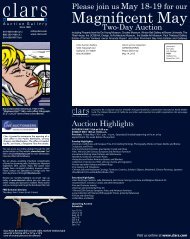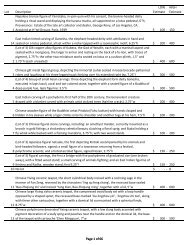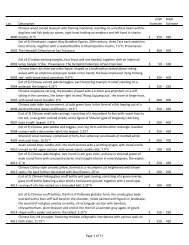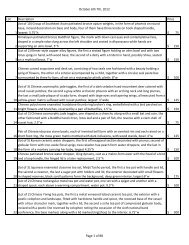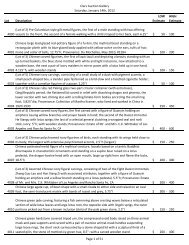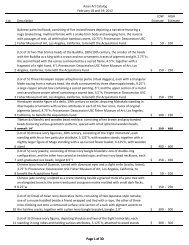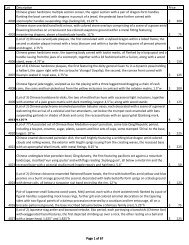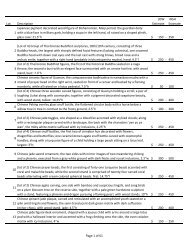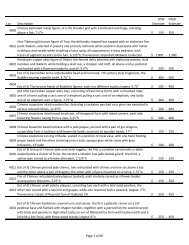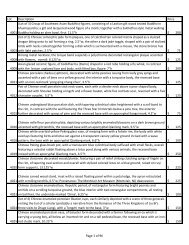2011 Lot Description Price - Clars Auction Gallery
2011 Lot Description Price - Clars Auction Gallery
2011 Lot Description Price - Clars Auction Gallery
Create successful ePaper yourself
Turn your PDF publications into a flip-book with our unique Google optimized e-Paper software.
2620<br />
2622<br />
2626<br />
2628<br />
2629<br />
2631<br />
2633<br />
<strong>Clars</strong> <strong>Auction</strong> <strong>Gallery</strong><br />
<strong>Price</strong>s Realized<br />
June 11th 12th, <strong>2011</strong><br />
Chinese polychrome enameled porcelain covered jar, late Qing/Republic period, of swelling hexagonal section<br />
decorated with coral enameled dragon and phoenix roundels reserved on a ground scattered with flowers,<br />
peach sprigs and insects, the recessed base bearing a Tongzhi mark; together with a lid accented by flaming<br />
jewels, 13.75''h $ 225<br />
Chinese enameled porcelain trompe l'oeil vase, featuring two shaped reserves brightly enameled with<br />
children on a garden terrace and reserved on a silver diaper ground molded with the Eight Daoist Treasures<br />
and lion‐mask and mock loose‐ring handles, a stiff leaf pattern on the flaring neck and a sawtooth band<br />
encircling the tall foot, an apocryphal Qianlong mark on the recessed base, 14.75''h $ 200<br />
Japanese Satsuma‐style Kinkozan studio polychrome enamel decorated vase, the sides molded with various<br />
luohan/rakan (Buddhist holy men) in a brightly colored landscape silhouetted against a dark blue ground, a<br />
shippo‐tsunagi band encircling the waisted neck, the base with a four character Kinkozan mark, 10''h $ 50<br />
Chinese massive underglaze blue porcelain rouleau vase, the cylindrical body decorated with a scene of the<br />
emperor receiving court officials and reversed by another official ocassion on a garden terrace, the base of<br />
the neck accented with scrolls and ruyi heads below further bands heightening a raised band encircling the<br />
neck below a dished rim, the recessed base with a underglaze blue double ring, 31.5''h $ 150<br />
Chinese large red enamel decorated porcelain tripod censor with cover (xiang lu), Guangxu mark and period,<br />
with a waisted neck above a compressed ovoid body raised on three splayed cabriole‐shaped legs and<br />
decorated in shades of red enamel with a dense pattern of stylized flowers and gourds amid scrolling tendrils<br />
repeated on the flat S‐shaped handles flanking the wide diaper‐patterned rim centered by two inscribed<br />
cartouches, one with the Manchu family name 'Hesheli' , the other with the studio name 'Chunyi Tang zhi', the<br />
low domical lid decorated en suite and surmounted by a gilt fu‐lion finial, the interior glazed turquoise, the<br />
unglazed base with a six‐character Guangxu mark and additional ink inscription 'Minguo dingchou nian jiu yue<br />
shiyi ri chong [wai], ye wang miao qing xi dao ren zhi Jieyang shisan yuan' (=dingchou year of the Republic<br />
[=1937] ninth month eleventh day, commissioned by Qingxi daoren of Yaowang temple), 14.5''h, with a fitted<br />
hardwood stand; Provenance: ex‐collection of Mrs. Woo Chen Zon Yin, purchased at Sotheby Parke Bernet,<br />
Hong Kong, November 4, 1974, lot #2, by Reynold Tom of Oakland, now offered by his family $ 19,000<br />
Chinese dark stained hardwood side table, with a rectangular floating top panel and with an ice‐plate edge<br />
above a simple apron with a beaded‐edge continuing on the straight supports with hoof‐form terminals and<br />
joined by humpback stretchers, 29''h x 60''h x 18''d $ 325<br />
Two Chinese hongmu continuous high‐back armchairs, Qing Dynasty, probably 18th century, each with a<br />
shaped top rail suspending a back splat composed of two vertical members divided into three panels<br />
consisting of two removable raised burlwood panels above a small openwork panel of stylized openwork<br />
design, the arms with slightly S‐shaped tapering side supports joined to the rectangular seat frame drilled for<br />
the soft cane seat woven with an 'an hua' pattern, the front with a conforming flat curvilinear apron with a<br />
beaded edge that continues down the front legs to the curvilinear stretcher while the back stiles continue<br />
through the mitered, mortised and tenoned frame of the seat to form the back legs/supports, the underside<br />
of the seat with a palm fiber under‐webbing and one transverse brace, traces of clay and lacquer<br />
undercoating (each leg now applied with removable ball feet, one chair with a repair to the stile), 38''h x 22''w<br />
x 18.5''d Provenance: private Oakland collection; Note: comparable examples in Robert Ellsworth's 'Chinese<br />
Hardwood Furniture in Hawaiian Collections', #64 and #65 $ 6,000<br />
Page 72 of 75



